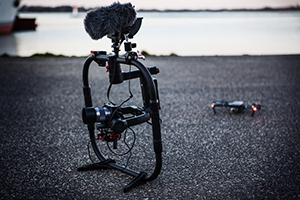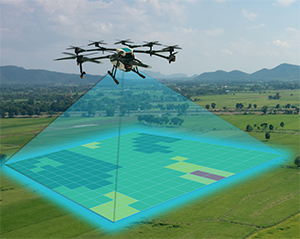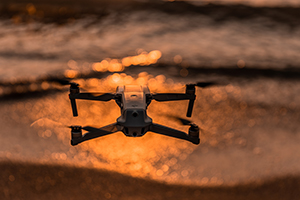How does Drone insurance work?

Hello!
Welcome to the first #MondayBlog of October!
In our last post we told you some stories of real accidents involving drones and today we want to explain how drone insurance works and, once again, emphasize its importance.
A LITTLE BIT ABOUT DRONES
As we said in our post “Discover the necessary care with Drones in different climates”, drones or UAS (unmanned aircraft system) were first seen in military situations. However, today, the UAS industry moves billions of dollars a year.
The fact of being a small machine, mostly versatile and with constant innovative technologies, makes this equipment a very interesting asset.
And did you know that drones exist for all kinds of tastes? And will likely be used in all types of industry?
Well, dear reader, it's not just in the audiovisual field that this little robot shines. It is used in disaster relief areas, to cover events, to help with the crops, and it also looks like it will be our new delivery systems, if companies like Amazon and Ifood succed in their efforts.
And its role in military conflicts remains strong, as well as studying its use in aiding the security of the population in large centers.
The drone market has grown and models have multiplied. There are at least 4 main formats of drones today:
- Fixed wing drone: is the fixed wing drone in the same shape as airplane wings;
- Drone Motor: this drone has wings that mimic those of helicopters;
- Quad-copters drone: this drone has helicopter propellers in its 4 corners;
- Multi-copter: has more than 4 helicopter propellers spread over its body.
Drones are true mobile technological innovations, with top-of-the-line software installed. For this reason, most of them are capable of automated take-off and landing, in addition to having GPS, timers, maps, battery information, and cameras, of course!
Some of them have even nicer commands, such as the ability to return home alone after the flight, plan their own itinerary, based on information collected by the software, which tells the drone where it cannot fly over, through crossing GPS information and radio frequencies.
Most people think that drones are exclusively controlled by remote controls, and yes, they are primarily piloted that way, but today there is already the possibility to use your tablet, notebook and cell phone to control your UAS, with peace of mind.
And did you know that drones can be charged with electricity, battery and fuel? Yes, the most robust drones need fuel to fly, just like any aircraft.
And now comes the icing on the cake, the cameras attached to the drones. That for audiovisual professionals they are fundamental to make those beautiful shots of landscapes and scenes of infinity. Drones can have simple cameras attached, or they can have high quality super cameras, which can cost more than $500,000.
And the value of these cameras is one of the reasons why having your drone insured is a very smart move.
So, after this long introduction, let's get down to business? The subject of our post, how does drone insurance work?
In the Brazilian market there are two types of covers available, but we are going a little further today.
Basically, there is hull coverage and liability coverage.

COVERAGES
Civil Liability
Liability insurance for drones is completely different from Liability insurance for manned aircraft, as the drone has neither a pilot nor people on board when it is in the air. Not to mention that a drone is infinitely smaller than an airplane, for example.
However, one of the great dangers of airborne drone is the possibility of collision with a commercial aircraft, for example. It is for this reason that several rules were put in place, with the aim of preventing curious people and malicious people from using their UAS near airports.
Any flight with drones must be allowed by the local legislation of the country in which you will be using the device, and at this point, drones with geofencing are super useful as they will prevent you from entering a prohibited flight area by accident, since it will literally see the digital fence as a physical obstacle and will not enter prohibited areas, preventing accidents and fines, or worse, lawsuits. Not to mention a huge civil lawsuit in the event of an accident.
The Liability coverage exists because, your drone can suffer a problem during the flight, fall and injure someone, as we saw in the last post, or damage the property of a third party.
That's why it's always good to carefully analyze your flight plan before going out to film, as we already explained in the post “Discover the necessary care with Drones in different climates”, heat, rain, wind, snow, sand and any excessive weather conditions can cause your equipment to crash. And an uncontrolled drone can be a nightmare, because despite being a small machine, it can cause some serious damage.
The name of insurance for drones in Brazil is RETA, or Civil Liability Insurance for the Operator or Air Carrier. This coverage is annual and, as we have already mentioned, essentially covers material or personal damage caused to third parties. Remembering that these third parties cannot have any relationship with the insured.
Oh, and your drone must be properly registered in the registry of the Unmanned Aircraft System (SISANT), if it weighs more than 250 grams, and if it is used in a commercial manner.
Abroad, the Liability insurance generally covers both the drone operator and the public with respect to the risk of mid-air collisions, as well as property damage and damage to people, property damage includes damage to the property of third parties and other aircraft .
Companies that sell drones, work with drones, or train drone operators typically take out General Liability insurance for exposure risk.
Hull Insurance
Hull insurance is another key coverage for drones. Remember we said at the beginning of the post that some drones have cameras attached that cost over 500,000 dollars? Can you imagine taking this out of the producer's pocket in case of a fatal drone fall?
A good drone today costs at least around 10 thousand reais. Not to mention all the installed technology, with high-generation software. Add that to a good camera, and taking your drone out without an insurance is an act of tremendous courage.
A stronger wind, or a loss of seconds of communication with your UAS can mean loss after loss.
So just to emphasize, the hull insurance means coverage for the entire exterior of your machine. And it essentially covers the total loss of equipment, as well as damage caused by falls from mechanical, electronic, or battery failure. And, it can also cover damage caused to all equipment attached to your drone. Tip: your super hi-tech camera.

SOME OTHER REALITIES WITH DRONES
Terrorism
Let's face it, it's not an unlikely scenario, and what a scary thought. Since drones are known weapons of war, if someone with bad intentions decides to use this technology for evil, the situation can get out of hand.
No wonder that all aviation agencies in the world want drones properly registered, in order to gain control and prevent such situations from happening.
The biggest fear of authorities is the use of UAS’ in attacks against stadiums, or events with a large crowd. In addition to the concern with attacks on electrical and nuclear networks. In France, for example, the government invested more than $1 million with the aim of detecting, identifying and neutralizing small drones, after more than a dozen drones hovered near electricity supply networks in 2014.
Cyber Attack
Remember drones are remotely controlled? Yeah, such a wonderful attribute, it can be fatal if a group of hackers decides to invade your network and take control of your drone.
One of the scenarios considered is the possibility of a hacker attack, causing drones to fall out of the air, purposely crash into commercial or military aircraft, causing material damage or, in the worst case, loss of life.
There is a term in English, which refers to attempts to taking control of drones, the "spoofing" happens when the hacker invades the UAS radio signal and sends other commands to the machine. And this risk is extremely real, as drones are guided by radio and Wi-Fi signals.
Not to mention the possible theft of the images collected by the drone's camera. Imagine recording a confidential project and having your work released online due to a cyber attack?
Loss of Privacy
There are reports of people being filmed by drones through their apartment windows.
Drones can become a nightmare in terms of privacy, space invasion and general irritation.
In Germany, a drone operator had to pay a fine of 250,000 euros for overflying his neighbor's land without prior authorization.

Despite all the bad things that can happen with the use of drones, this equipment when used for good, remains fantastic. Just remember the images captured, the help with the crops fields, and in situations of natural disasters, when flying over places in search of survivors. The good outweighs the bad. As it should.
However, we at Prospecto believe that it is always good to consider the risks inherent in using a drone and look for a complete insurance solution. Whether for specific filming on a project or for the annual coverage of the equipment. You can't play with that kind of risk. The financial loss is too high.
A drone, if it falls on a person, can cause both a slight injury, the loss of a limb, and even a fatal wound. Just think of its propellers.
If a drone collides with a plane, that plane may crash.
If a drone lands on a car parked on the street, you can be sure there will be material damage.
The possibilities are endless, which is why we are here to help you find the best drone insurance solution.
We hope today's topic was as interesting to you as it was to us.
Well then, have you insured your drone?
Make a free quote with Prospecto and start living protected.
We're waiting for you for the next #MondayBlog.
Have a great week, lovers!
Prospecto Seguros
Learn more:
Drones
Errors and Omissions
Equipments
Audiovisual Production
Life and Personal Accidents